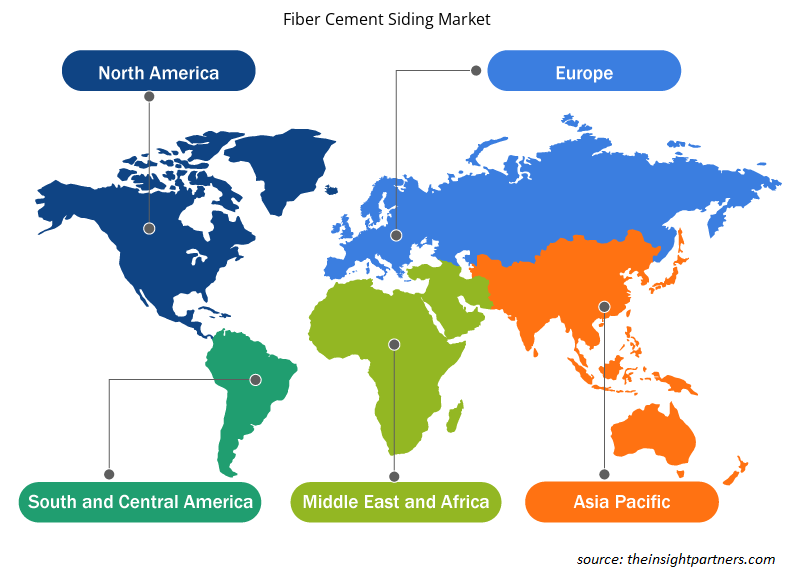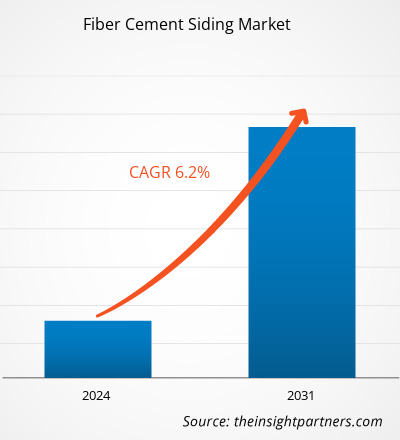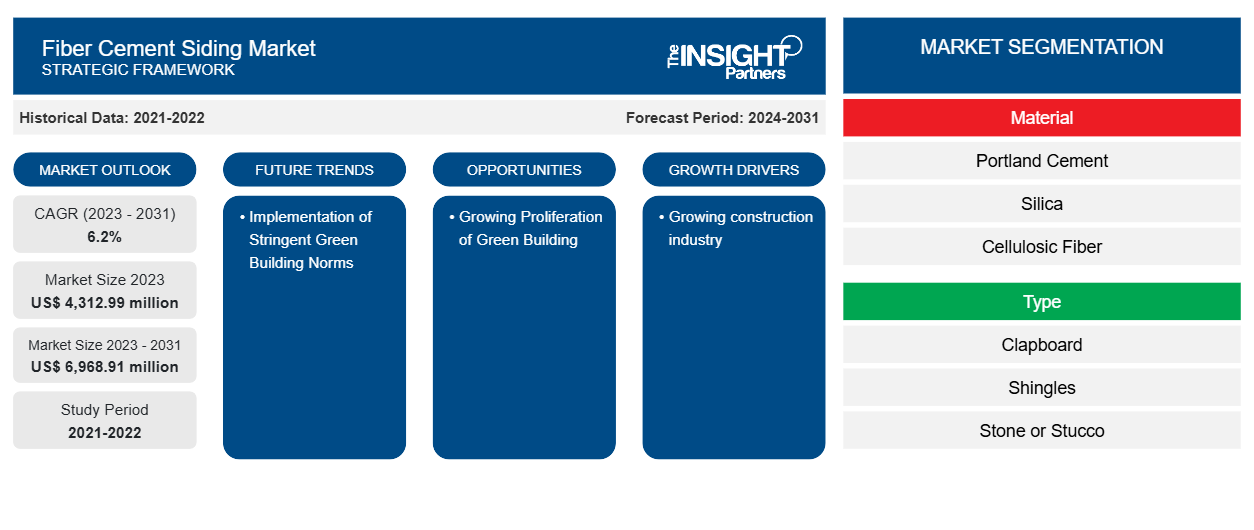Si prevede che la dimensione del mercato del rivestimento in fibrocemento raggiungerà i 6.968,91 milioni di dollari entro il 2031, rispetto ai 4.312,99 milioni di dollari del 2023. Si prevede che il mercato registrerà un CAGR del 6,2% nel periodo 2023-2031. Il crescente numero di sviluppo di infrastrutture residenziali e commerciali e la crescente attenzione allo sfruttamento del rivestimento in cemento a basso costo rimarranno probabilmente una tendenza chiave nel mercato.
Analisi di mercato del rivestimento in fibrocemento
Si prevede che il crescente sviluppo nel settore delle costruzioni aumenterà lo sviluppo dei rivestimenti in fibrocemento a livello globale. Il settore delle costruzioni nei paesi sviluppati come gli Stati Uniti, il Canada, il Regno Unito, tra gli altri, è cresciuto a un ritmo significativo negli ultimi anni. I governi di questi paesi stanno incoraggiando le partnership pubblico-private per l'implementazione di lavori residenziali, commerciali e infrastrutturali. Ciò ha ulteriormente portato a una maggiore costruzione di edifici residenziali e commerciali a livello globale negli ultimi tempi, il che sta incoraggiando la crescita del mercato dei rivestimenti in fibrocemento.
Panoramica del mercato dei rivestimenti in fibrocemento
Si prevede che l'aumento della costruzione di edifici residenziali e commerciali fornirà opportunità prospere per la crescita del mercato a livello globale, influenzando così positivamente la domanda di rivestimenti in fibrocemento. Insieme a ciò, anche i progetti di città intelligenti stanno agendo come un motore del mercato dei rivestimenti in fibrocemento. I redditi disponibili più elevati degli individui dovuti alla prosperità economica sono stati un fattore importante che ha guidato il mercato dei rivestimenti in fibrocemento nel settore degli edifici residenziali. Pertanto, il crescente numero di attività di costruzione sta portando alla domanda positiva di rivestimenti in fibrocemento a livello globale.
Personalizza questo report in base alle tue esigenze
Riceverai la personalizzazione gratuita di qualsiasi report, comprese parti di questo report, o analisi a livello nazionale, pacchetto dati Excel, oltre a usufruire di grandi offerte e sconti per start-up e università
-
Scopri le principali tendenze di mercato in questo rapporto.Questo campione GRATUITO includerà analisi di dati che spaziano dalle tendenze di mercato alle stime e alle previsioni.
Driver e opportunità del mercato dei rivestimenti in fibrocemento
Sviluppo crescente nel settore delle costruzioni per favorire il mercato
La popolazione in crescita ha portato a una domanda elevata di attività di costruzione residenziale e commerciale a livello globale. Regioni come Europa, Nord America, Asia Pacifico e Medio Oriente comprendono diversi paesi in via di sviluppo, che generano una forte domanda di progetti infrastrutturali. La popolazione crescente di questi paesi è il principale motore per l'industria immobiliare della regione, che stimolerà il mercato dei rivestimenti in fibrocemento a livello globale. Con la fiorente costruzione di edifici commerciali e residenziali, il mercato dei rivestimenti in fibrocemento sta aumentando in diversi paesi come Cina e Giappone a causa di diversi vantaggi come risparmi energetici e sui costi a lungo termine, minori emissioni e impatto ambientale complessivo, migliore comfort termico e consiste in una ventilazione continua e aria fresca in tutto l'edificio che porta a un comfort e una salute migliorati. Il crescente concetto di edifici a risparmio energetico sta anche stimolando la crescita del mercato dei rivestimenti in fibrocemento.
Crescente proliferazione di edifici ecologici
Diverse iniziative governative volte all'introduzione di edifici efficienti dal punto di vista energetico e rispettosi dell'ambiente stanno incrementando la domanda per il mercato dei rivestimenti in fibrocemento. Ad esempio, Germania e Regno Unito sono i principali paesi che si concentrano sulla costruzione di edifici efficienti dal punto di vista energetico grazie ai rispettivi investimenti governativi. Questo fattore sta incrementando la crescita del mercato dei rivestimenti in fibrocemento. Si prevede che il progresso tecnologico per lo sviluppo dei settori residenziali e commerciali in linea con gli obiettivi di sostenibilità ambientale attirerà attori locali e globali per offrire rivestimenti in fibrocemento di qualità, che si prevede aumenteranno le opportunità per il mercato nel periodo di previsione.
Analisi della segmentazione del rapporto di mercato del rivestimento in fibrocemento
I segmenti chiave che hanno contribuito alla derivazione dell'analisi di mercato del rivestimento in fibrocemento sono il tipo di prodotto, l'applicazione e l'utente finale.
- In base al materiale, il mercato del rivestimento in fibrocemento è suddiviso in cemento Portland, silice, fibra cellulosica e altri. Il segmento del cemento Portland ha detenuto una quota di mercato maggiore nel 2023.
- Per tipo, il mercato è segmentato in assicelle, scandole e pietra o stucco. Il segmento assicelle ha detenuto una quota significativa del mercato nel 2023.
- In base all'utente finale, il mercato è segmentato in residenziale e commerciale. Il segmento residenziale ha detenuto una quota significativa del mercato nel 2023.
Analisi della quota di mercato del rivestimento in fibrocemento per area geografica
L'ambito geografico del rapporto sul mercato dei rivestimenti in fibrocemento è suddiviso principalmente in cinque regioni: Nord America, Asia Pacifico, Europa, Medio Oriente e Africa, e Sud e Centro America.
Il Nord America è leader del mercato. L'economia del Nord America è considerata una delle più grandi al mondo. I paesi nordamericani comprendono alcune delle più grandi multinazionali nei loro territori. Gli Stati Uniti hanno un numero maggiore di attori del mercato del rivestimento in fibrocemento rispetto al mondo. Le aziende di costruzione situate nella regione traggono vantaggio dalle strutture sviluppate disponibili. Essere un'economia solida consente al governo di spendere di più in lavori di costruzione per una maggiore urbanizzazione. Ciò aiuta anche nella costruzione di edifici nella regione, il che sosterrà la crescita del mercato del rivestimento in fibrocemento nella regione.
Approfondimenti regionali sul mercato dei rivestimenti in fibrocemento
Le tendenze regionali e i fattori che influenzano il Fiber Cement Siding Market durante il periodo di previsione sono stati ampiamente spiegati dagli analisti di Insight Partners. Questa sezione discute anche i segmenti e la geografia del Fiber Cement Siding Market in Nord America, Europa, Asia Pacifico, Medio Oriente e Africa e Sud e Centro America.

- Ottieni i dati specifici regionali per il mercato dei rivestimenti in fibrocemento
Ambito del rapporto di mercato del rivestimento in fibrocemento
| Attributo del report | Dettagli |
|---|---|
| Dimensioni del mercato nel 2023 | 4.312,99 milioni di dollari USA |
| Dimensioni del mercato entro il 2031 | 6.968,91 milioni di dollari USA |
| CAGR globale (2023-2031) | 6,2% |
| Dati storici | 2021-2022 |
| Periodo di previsione | 2024-2031 |
| Segmenti coperti |
Per materiale
|
| Regioni e Paesi coperti |
America del Nord
|
| Leader di mercato e profili aziendali chiave |
|
Densità degli attori del mercato: comprendere il suo impatto sulle dinamiche aziendali
Il mercato del Fiber Cement Siding Market sta crescendo rapidamente, spinto dalla crescente domanda degli utenti finali dovuta a fattori quali l'evoluzione delle preferenze dei consumatori, i progressi tecnologici e una maggiore consapevolezza dei vantaggi del prodotto. Con l'aumento della domanda, le aziende stanno ampliando le loro offerte, innovando per soddisfare le esigenze dei consumatori e capitalizzando sulle tendenze emergenti, il che alimenta ulteriormente la crescita del mercato.
La densità degli operatori di mercato si riferisce alla distribuzione di aziende o società che operano in un particolare mercato o settore. Indica quanti concorrenti (operatori di mercato) sono presenti in un dato spazio di mercato in relazione alle sue dimensioni o al valore di mercato totale.
Le principali aziende che operano nel mercato dei rivestimenti in fibrocemento sono:
- Gruppo Swisspearl SA
- CSR limitata
- Elementia SAB DE CV
- Gruppo ETEX
- Società di materiali GAF
- James Hardie Industries Plc
Disclaimer : le aziende elencate sopra non sono classificate secondo un ordine particolare.

- Ottieni una panoramica dei principali attori del mercato dei rivestimenti in fibrocemento
Notizie e sviluppi recenti sul mercato dei rivestimenti in fibrocemento
Il mercato dei rivestimenti in fibrocemento viene valutato raccogliendo dati qualitativi e quantitativi dopo la ricerca primaria e secondaria, che include importanti pubblicazioni aziendali, dati associativi e database. Di seguito sono elencati alcuni degli sviluppi nel mercato dei rivestimenti in fibrocemento:
- Swisspearl Group di Niederurnen, Svizzera, ha acquisito la danese Cembrit. (Fonte: Swisspearl Group, comunicato stampa, giugno 2022)
- James Hardie Industries Plc ha acquisito un terreno a Melbourne, Victoria, per avviare uno stabilimento di produzione di pannelli in fibrocemento. (Fonte: James Hardie Industries Plc, comunicato stampa, marzo 2022)
Copertura e risultati del rapporto sul mercato dei rivestimenti in fibrocemento
Il rapporto "Dimensioni e previsioni del mercato dei rivestimenti in fibrocemento (2021-2031)" fornisce un'analisi dettagliata del mercato che copre le seguenti aree:
- Dimensioni e previsioni del mercato dei rivestimenti in fibrocemento a livello globale, regionale e nazionale per tutti i principali segmenti di mercato coperti dall'ambito
- Tendenze del mercato dei rivestimenti in fibrocemento e dinamiche di mercato come fattori trainanti, vincoli e opportunità chiave
- Analisi PEST e SWOT dettagliate
- Analisi di mercato del rivestimento in fibrocemento che copre le principali tendenze del mercato, il quadro globale e regionale, i principali attori, le normative e i recenti sviluppi del mercato
- Analisi del panorama industriale e della concorrenza che copre la concentrazione del mercato, l'analisi della mappa termica, i principali attori e gli sviluppi recenti per il mercato dei rivestimenti in fibrocemento
- Profili aziendali dettagliati
- Analisi storica (2 anni), anno base, previsione (7 anni) con CAGR
- Analisi PEST e SWOT
- Valore/volume delle dimensioni del mercato - Globale, Regionale, Nazionale
- Industria e panorama competitivo
- Set di dati Excel
Report recenti
Rapporti correlati
Testimonianze
Motivo dell'acquisto
- Processo decisionale informato
- Comprensione delle dinamiche di mercato
- Analisi competitiva
- Analisi dei clienti
- Previsioni di mercato
- Mitigazione del rischio
- Pianificazione strategica
- Giustificazione degli investimenti
- Identificazione dei mercati emergenti
- Miglioramento delle strategie di marketing
- Aumento dell'efficienza operativa
- Allineamento alle tendenze normative























 Ottieni un campione gratuito per - Mercato dei rivestimenti in fibrocemento
Ottieni un campione gratuito per - Mercato dei rivestimenti in fibrocemento